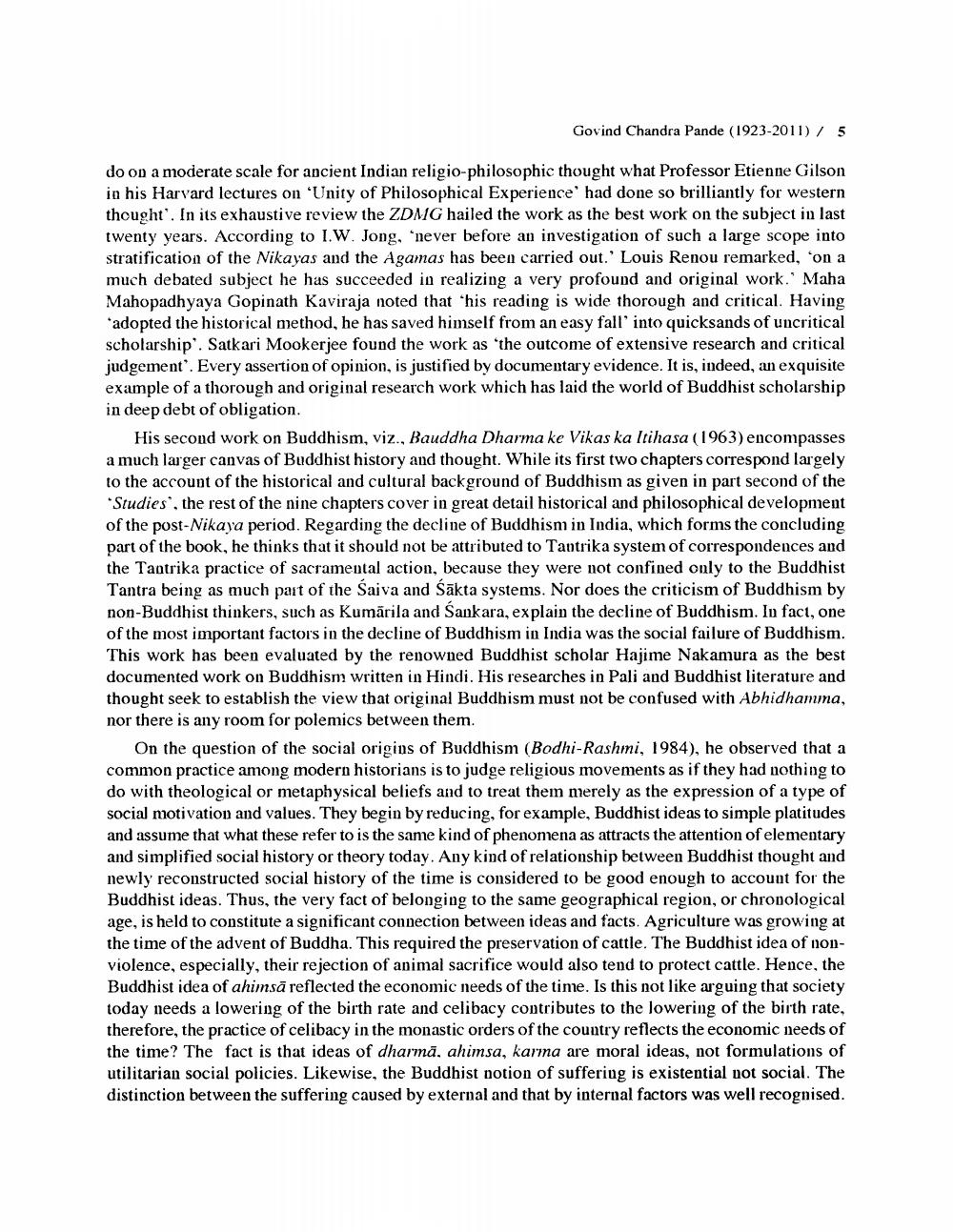________________
Govind Chandra Pande (1923-2011) / 5
do on a moderate scale for ancient Indian religio-philosophic thought what Professor Etienne Gilson in his Harvard lectures on 'Unity of Philosophical Experience' had done so brilliantly for western thought'. In its exhaustive review the ZDMG hailed the work as the best work on the subject in last twenty years. According to I.W. Jong, 'never before an investigation of such a large scope into stratification of the Nikayas and the Agamas has been carried out.' Louis Renou remarked, on a much debated subject he has succeeded in realizing a very profound and original work.' Maha Mahopadhyaya Gopinath Kaviraja noted that his reading is wide thorough and critical. Having 'adopted the historical method, he has saved himself from an easy fall' into quicksands of uncritical scholarship'. Satkari Mookerjee found the work as 'the outcome of extensive research and critical judgement'. Every assertion of opinion, is justified by documentary evidence. It is indeed, an exquisite example of a thorough and original research work which has laid the world of Buddhist scholarship in deep debt of obligation.
His second work on Buddhism, viz., Bauddha Dharma ke Vikas ka Itihasa (1963) encompasses a much larger canvas of Buddhist history and thought. While its first two chapters correspond largely to the account of the historical and cultural background of Buddhism as given in part second of the *Studies, the rest of the nine chapters cover in great detail historical and philosophical development of the post-Nikaya period. Regarding the decline of Buddhism in India, which forms the concluding part of the book, he thinks that it should not be attributed to Tantrika system of correspondences and the Tantrika practice of sacramental action, because they were not confined only to the Buddhist Tantra being as much part of the Saiva and Sākta systems. Nor does the criticism of Buddhism by non-Buddhist thinkers, such as Kumärila and Sankara, explain the decline of Buddhism. In fact, one of the most important factors in the decline of Buddhism in India was the social failure of Buddhism. This work has been evaluated by the renowned Buddhist scholar Hajime Nakamura as the best documented work on Buddhism written in Hindi. His researches in Pali and Buddhist literature and thought seek to establish the view that original Buddhism must not be confused with Abhidhamma, nor there is any room for polemics between them.
On the question of the social origins of Buddhism (Bodhi-Rashmi, 1984), he observed that a common practice among modern historians is to judge religious movements as if they had nothing to do with theological or metaphysical beliefs and to treat them merely as the expression of a type of social motivation and values. They begin by reducing, for example, Buddhist ideas to simple platitudes and assume that what these refer to is the same kind of phenomena as attracts the attention of elementary and simplified social history or theory today. Any kind of relationship between Buddhist thought and newly reconstructed social history of the time is considered to be good enough to account for the Buddhist ideas. Thus, the very fact of belonging to the same geographical region, or chronological age, is held to constitute a significant connection between ideas and facts. Agriculture was growing at the time of the advent of Buddha. This required the preservation of cattle. The Buddhist idea of nonviolence, especially, their rejection of animal sacrifice would also tend to protect cattle. Hence, the Buddhist idea of ahimsā reflected the economic needs of the time. Is this not like arguing that society today needs a lowering of the birth rate and celibacy contributes to the lowering of the birth rate, therefore, the practice of celibacy in the monastic orders of the country reflects the economic needs of the time? The fact is that ideas of dharmā, ahimsa, karma are moral ideas, not formulations of utilitarian social policies. Likewise, the Buddhist notion of suffering is existential not social. The distinction between the suffering caused by external and that by internal factors was well recognised.




